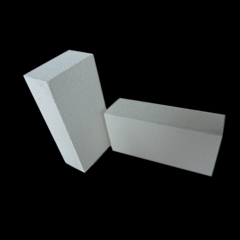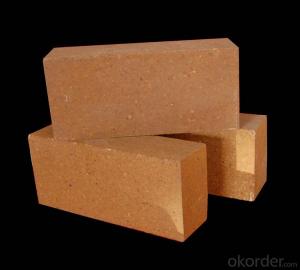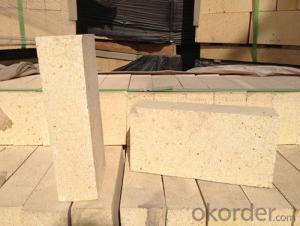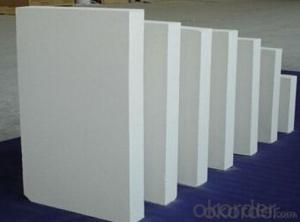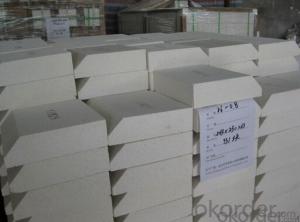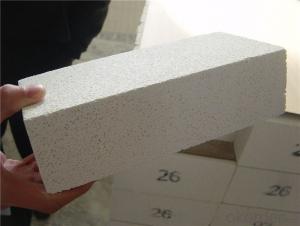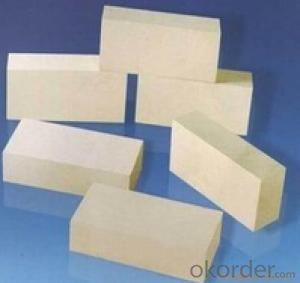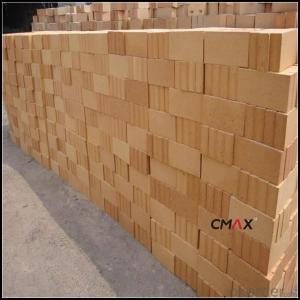Insulating Fire Brick - Insultaing Fire Brick
- Loading Port:
- China Main Port
- Payment Terms:
- TT OR LC
- Min Order Qty:
- -
- Supply Capability:
- -
OKorder Service Pledge
Quality Product, Order Online Tracking, Timely Delivery
OKorder Financial Service
Credit Rating, Credit Services, Credit Purchasing
You Might Also Like
General Information
CMAX insulating firebricks are classified under temperature between 1300℃ to 1700℃, manufactured from high purity alumina clay.
Feature
Light weight and low thermal conductivity
Low heat storage
Low iron and impurities
High thermal shock resistance
Application
CMAX insulating firebricks can be used as a hot face lining directly exposed to the heat or as a backup insulation layer in iron and steel mills, non-ferrous foundries, petrochemical, ceramic, glass.
- Q: Can insulating fire bricks be used in the construction of smelters or foundries?
- Yes, insulating fire bricks can be used in the construction of smelters or foundries. Insulating fire bricks have excellent thermal insulation properties and can withstand high temperatures, making them suitable for lining the walls and floors of smelters or foundries. They help to retain heat, improve energy efficiency, and protect the surrounding structures from extreme temperatures.
- Q: How do insulating fire bricks help improve the efficiency of heat treatment processes?
- Insulating fire bricks help improve the efficiency of heat treatment processes by effectively reducing heat loss. Due to their low thermal conductivity, these bricks act as a barrier, preventing heat from escaping and maintaining high temperatures for longer periods. This allows the heat treatment process to be more energy-efficient, as less energy is required to achieve and maintain the desired temperatures. Additionally, insulating fire bricks help to evenly distribute heat, resulting in more consistent and uniform heat treatment outcomes.
- Q: Are insulating fire bricks easy to cut or shape?
- Compared to other bricks, insulating fire bricks offer a relatively simple cutting and shaping process. This is mainly because of their lower density and composition, enabling easier manipulation using standard masonry tools. However, it is crucial to acknowledge that the level of simplicity can differ depending on the specific type and brand of insulating fire brick. Some may demand special tools or techniques for cutting or shaping, while others may be more user-friendly. To ensure accurate cutting or shaping techniques, it is always advisable to refer to the manufacturer's instructions or seek professional guidance when working with insulating fire bricks.
- Q: Can insulating fire bricks be used in the construction of smelting crucibles?
- Yes, insulating fire bricks can be used in the construction of smelting crucibles. The high heat resistance and insulating properties of these bricks make them suitable for withstanding the extreme temperatures required in the smelting process.
- Q: Are insulating fire bricks resistant to acids?
- Insulating fire bricks, also known as refractory bricks, are generally resistant to acids. These bricks are made from high temperature-resistant materials such as silica, alumina, and other refractory oxides, which provide excellent resistance to chemical attack. However, it is important to note that the level of acid resistance can vary depending on the specific composition and manufacturing process of the insulating fire bricks. It is recommended to consult the manufacturer or supplier for detailed information about the acid resistance of the specific type of insulating fire bricks being used.
- Q: Can insulating fire bricks be used in rocket stoves?
- Yes, insulating fire bricks can be used in rocket stoves. Insulating fire bricks are designed to withstand high temperatures and provide excellent insulation, which makes them ideal for use in rocket stoves. They help to retain heat efficiently, ensuring better combustion and increased fuel efficiency in rocket stoves.
- Q: How do insulating fire bricks help improve the efficiency of heating systems?
- Insulating fire bricks help improve the efficiency of heating systems by reducing heat loss. These bricks are designed to have low thermal conductivity, which means they can effectively trap and retain heat within the heating system. By minimizing heat loss, insulating fire bricks help the heating system operate more efficiently, requiring less energy to maintain the desired temperature.
- Q: Can insulating fire bricks be used for insulation in industrial chimneys?
- Indeed, insulating fire bricks have the capability to serve as insulation in industrial chimneys. These bricks are specially crafted to endure extreme temperatures and offer exceptional insulation characteristics. Comprised of lightweight refractory materials boasting low thermal conductivity, insulating fire bricks successfully retain heat and hinder its dispersion into the environment. Consequently, they prove to be optimal for employment in industrial chimneys, as insulation plays a vital role in diminishing heat loss and enhancing energy efficiency. Furthermore, insulating fire bricks exhibit resistance against chemical corrosion, rendering them well-suited for the hostile and corrosive settings frequently encountered in industrial chimneys.
- Q: Are insulating fire bricks resistant to acid attack?
- Insulating fire bricks are known for their resistance to acid attack. They are manufactured using durable materials that can withstand high temperatures and offer excellent insulation properties. These bricks are typically composed of lightweight refractory materials like alumina, silica, and other refractory oxides, which are renowned for their ability to resist chemical corrosion, including acids. Nevertheless, it is crucial to acknowledge that the acid resistance of insulating fire bricks can vary depending on their specific composition and manufacturing process. Some bricks may exhibit higher resistance to acids than others. Therefore, it is advisable to consult the manufacturer or supplier for detailed information regarding the acid resistance of their insulating fire bricks. Generally, insulating fire bricks are widely used in various applications where they may encounter acids, such as industrial furnaces, kilns, and high-temperature environments. They are valued for their durability and capacity to withstand harsh chemical surroundings, including acid exposure. However, it is always essential to consider the precise chemical composition and concentration of the acids involved, as well as the temperature conditions, to determine the suitability of insulating fire bricks for a particular application.
- Q: Are insulating fire bricks resistant to insects and rodents?
- Yes, insulating fire bricks are generally resistant to insects and rodents due to their dense and solid construction, which makes it difficult for pests to penetrate or damage them.
Send your message to us
Insulating Fire Brick - Insultaing Fire Brick
- Loading Port:
- China Main Port
- Payment Terms:
- TT OR LC
- Min Order Qty:
- -
- Supply Capability:
- -
OKorder Service Pledge
Quality Product, Order Online Tracking, Timely Delivery
OKorder Financial Service
Credit Rating, Credit Services, Credit Purchasing
Similar products
Hot products
Hot Searches
Related keywords

